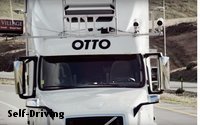 Connected and self-driving cars might no longer be an idea of the distant future with pushes from Audi, Uber and Volvo.
Connected and self-driving cars might no longer be an idea of the distant future with pushes from Audi, Uber and Volvo.
In addition to the recent move by Uber to launch
driverless cars in Pittsburgh later this month, major dollars are flowing toward connecting vehicles with other systems as well.
Global spending on connected cars will reach $30 billion by the
end of next year and governments will spend $17 billion on intelligent transportation systems, according to recent research from IDC.
"Connected cars have reached critical mass and their
interaction with the transportation infrastructure within Smart Cities is ongoing," said the authors of the IDC report.
"Automotive OEMs and Smart City leaders will need to work closely to
ensure the continued development of, and support for, connected car capabilities and services such as vehicle-to-vehicle and vehicle-to-infrastructure (V-to-I) communications that will increasingly
include autonomous operations,” the authors said.
Audi is implementing vehicle-to-infrastructure connection capabilities in its Q7 and A4 models currently being manufactured, according
to a Reuters report.
Equipped with this V-to-I capability, the cars communicate with city infrastructure systems to receive safety and operational data.
For example, when approaching a
red traffic light, the cars display a countdown on the dashboard of the time until it turns green. Conversely, a countdown appears when approaching a green light to determine if the driver will have
enough time to make the light before it turns red, according to Reuters.
The feature is being positioned as a convenience for drivers, but Audi could expand the capability to more autonomous
options in the future. One possibility could be connecting the data from lights to a car’s navigation system to identify the time between lights, and ultimately the speed needed to match that
timing, Reuters reports.
On the fully autonomous side of vehicles, Uber says it is teaming up with Volvo to introduce self-driving cars into their market in Pittsburgh later this month.
Along with a $300 million pact with Volvo to develop a fully autonomous vehicle by 2021, the ride-sharing brand plans to roll out 100 custom SUVs in PA by the end of this year.
The Uber
Volvos will have various cameras, laser sensors, radar and GPS on-board to navigate cities and detect obstacles. Additionally, all of the driving data will be collected and analyzed to improve
self-driving performance and safety, according to Bloomberg.
For the immediate future, Uber’s self-driving cars will still have an engineer behind the wheel to take control when the
self-driving computer system encounters an unfamiliar situation, as well as another passenger taking notes.
During the initial pilot, self-driving Uber riders will be chosen at random and will
be free to consumers. Additionally, the cars will be equipped with tablets in the back seats displaying information about the vehicles.
The computer driving the car is optimized for urban
operation and gathers its spatial awareness from nearby buildings and physical objects. As a result, the system reportedly does not do well on bridges and defers to the human behind the wheel.
Uber also last month announced plans to acquire self-driving truck company OTTO for an estimated $680 million, according to a Bloomberg report.
This appears to be a sign that Uber is
serious about competing against major players like Google and Apple in the race toward realizing, and ultimately commercializing, driverless vehicles.